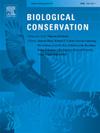Between hype and hope: De-extinction is a tool, not a panacea for the biodiversity crisis
IF 4.4
1区 环境科学与生态学
Q1 BIODIVERSITY CONSERVATION
引用次数: 0
Abstract
With recent claims of dire wolf resurrection, de-extinction has refueled public imagination and scientific controversy. This piece critically examines the promises and pitfalls of de-extinction, aiming to disentangle genuine advancements from inflated expectations. While substantial obstacles remain for de-extinction to move from lab breakthroughs to functional wild populations, the technologies behind it have catalyzed substantial and transferable advances in biotechnology, conservation biology, and public engagement, provocatively positioning de-extinction as a new era in conservation. However, scientific, ethical, and practical concerns remain. Chief among these concerns are media distortion, potential diversion of funding from urgent conservation needs, animal welfare risks, and unresolved legal frameworks. Rather than a panacea for the biodiversity crisis, de-extinction should be seen as a supplementary tool for conservation—valuable when used with responsibility and ecological purposefulness. Between hype and hope, there is room for thoughtful progress, one that recognizes limitations, reinforces urgent conservation priorities, and reimagines what future biodiversity stewardship looks like.
在炒作和希望之间:反灭绝是一种工具,而不是解决生物多样性危机的灵丹妙药
随着最近可怕的狼复活的说法,重新灭绝已经激起了公众的想象力和科学争议。这篇文章批判性地审视了反灭绝的承诺和陷阱,旨在将真正的进步与夸大的期望区分开来。虽然从实验室的突破到功能性野生种群的恢复仍然存在巨大障碍,但其背后的技术已经催化了生物技术,保护生物学和公众参与方面的实质性和可转移的进步,将恢复灭绝定位为保护的新时代。然而,科学、伦理和实际问题仍然存在。这些担忧中最主要的是媒体歪曲、可能从紧急保护需求中转移资金、动物福利风险以及未解决的法律框架。反灭绝不是解决生物多样性危机的灵丹妙药,而应被视为保护的一种补充工具——在负责任和有生态目的的情况下使用是有价值的。在炒作和希望之间,有深思熟虑的进步空间,认识到局限性,加强紧急保护优先事项,并重新设想未来生物多样性管理的样子。
本文章由计算机程序翻译,如有差异,请以英文原文为准。
求助全文
约1分钟内获得全文
求助全文
来源期刊

Biological Conservation
环境科学-环境科学
CiteScore
10.20
自引率
3.40%
发文量
295
审稿时长
61 days
期刊介绍:
Biological Conservation is an international leading journal in the discipline of conservation biology. The journal publishes articles spanning a diverse range of fields that contribute to the biological, sociological, and economic dimensions of conservation and natural resource management. The primary aim of Biological Conservation is the publication of high-quality papers that advance the science and practice of conservation, or which demonstrate the application of conservation principles for natural resource management and policy. Therefore it will be of interest to a broad international readership.
 求助内容:
求助内容: 应助结果提醒方式:
应助结果提醒方式:


